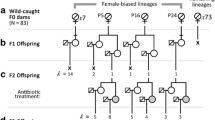Summary
-
1.
Cardinal inDrosophila subobscura, now called vermilion, is homologous with vermilion inD. melanogaster.
-
2.
Scarlet and cherry implants are autonomous in wild-type hosts and are not homologous with cinnabar.
-
3.
Poppy implants are autonomous in wild-type hosts, but poppy maroon implants are pinker in wild-type hosts. Poppy may behave like bright inD. melanogaster.
-
4.
Wild type is autonomous in maroon. Maroon is therefore not homologous with claret.
Similar content being viewed by others
References
Beadle, G. W. (1937). The development of eye colours inDrosophila as studied by transplantation.Amer. Nat.,71, 120–6.
Beadle, G. W., Anderson, R. L. &Maxwell, J. (1938). A comparison of the diffusible substances concerned with eye-colour development inDrosophila, Ephestia andHabrobracon.Proc., Nat. Acad. Sci., Wash.,24, 80–5.
Beadle, G. W. &Ephrussi, B. (1936). The differentiation of eye pigments inDrosophila as studied by transplantation.Genetics,21, 225–47.
Beadle, G. W. &Ephrussi, B. (1937). Development of eye colours inDrosophila: The mutants bright and mahogany.Amer. Nat.,71, 91–5.
Becker, E. (1939). Über die Natur des Augenpigments vonEphestia kühniella und seinen Vergleich mit den Augenpigmenten anderer Insekten.Biol. Zbl.,59, 597–627.
Butenandt, A., Weidel, W. &Becker, E. (1940). Kynurenine als augenpigmentbildungauslösendes Agens bei Insekten.Naturwissenschaften,28, 63.
Caspari, Ernst (1946). On the effects of the genea on the chemical composition ofEphestia kühniella Zeller.Genetics,31, 454–75.
Ephrussi, B. (1942a). Chemistry of ‘eye colour hormones’ ofDrosophila.Quart. Rev. Biol.,17, 327–38.
Ephrussi, B. (1942b). Analysis of eye colour differentiation inDrosophila.Cold Spr. Harb. Symp. Quant. Biol.,10, 40–8.
Ephrussi, B. &Beadle, G. W. (1936). Development of eye colours inDrosophila: Studies on the mutant claret.J. Genet.,33, 407–10.
Gottschewski, G. &Tan, C. C. (1937). Die Homologie der, Augenfarbgene vonDrosophila melanogaster undDrosophila pseudoobscura, bestimmt durch das Transplantationexperiment.Biol. Zbl.,57, 5/6.
Howland, R. B., Glancy, E. A. &Sonneblick, B. P. (1937). Transplantation of wild type and vermilion eye disks among 4 species ofDrosophila.Genetics,22, 435–42.
Kikkawa, Hideo (1941). The mechanism of pigment formation inBombyx andDrosophila.Genetics,26, 587–608.
Author information
Authors and Affiliations
Rights and permissions
About this article
Cite this article
Rendel, J.M., Suley, A.C.E. Genetics and cytology ofDrosophila subobscura . Journ. of Genet 49, 38–41 (1948). https://doi.org/10.1007/BF02986380
Issue Date:
DOI: https://doi.org/10.1007/BF02986380




